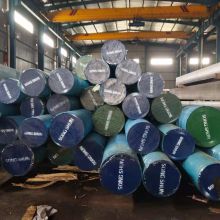Custom High Tensile Strength Alloy Structural Steel Used As Mechanical Parts
USD $8 - $15 /Ton
Min.Order:1 Ton
Quick Details View All >
Dongguan City Song Shun Mould Steel Products Co., Ltd.
Product Details
Alloy Structural Steel Classification
Alloy structural steel is generally divided into quenched and tempered structural steel and case-hardened structural steel.
① The carbon content of quenched and tempered structural steel is generally about 0.25% to 0.55%. For structural parts of a given cross-sectional size, during the quenching and tempering treatment (quenching and tempering), if it is quenched along the section, the mechanical properties It is good, but if hardenability is not carried out and free ferrite appears in the microstructure, the toughness decreases. For steels with a tendency to temper brittleness, such as manganese steel, chromium steel, nickel-chromium steel, etc., they should be cooled quickly after tempering. The quenching critical diameter of this type of steel increases with the increase in grain size and alloying element content. For example, 40Cr and 35SiMn steels are about 30 to 40 mm, while 40CrNiMo and 30CrNi2MoV steels are about 60 to 100 mm. Structural parts such as shafts and connecting rods with large loads.
②Surface hardening structural steel is used to manufacture parts with hard and wear-resistant surface and flexible core, such as gears, shafts, etc. In order to make the toughness of the core of the part high, the carbon content in the steel should be low, generally 0.12 to 0.25%, and there should be an appropriate amount of alloying elements to ensure suitable hardenability. Nitride steel also needs to add alloying elements (such as Al, Cr, Mo, etc.) that are easy to form nitrides. Carburizing or carbonitriding steel, after carburizing or carbonitriding at 850~950℃, quenched and used in low temperature tempering (about 200℃). Nitrided steel is treated by nitriding (480~580℃) and used directly without quenching and tempering.
Production Process
According to the steel grade and steel quality requirements, the smelting of alloy structural steel can be carried out by oxygen top-blown converter, open hearth, electric arc furnace; or by electroslag remelting and vacuum degassing. The ingot can be cast by continuous casting or die casting. The ingot should be slowly cooled or hot forged and rolled. When the ingot is heated, the temperature should be uniform and there should be sufficient holding time to improve segregation defects and avoid uneven deformation during forging and rolling; the steel after forging and rolling is small in size, especially carburizing with a carbon content of about 0.2%. Steel should be cooled rapidly at temperatures above 600°C to avoid aggravating the banded structure; for forgings with larger cross-sections, measures should be taken to eliminate internal stress and white spots. Quenched and tempered steel should be quenched into martensite structure as much as possible, and then tempered into sorbite structure; in the carburizing process of carburized steel, the concentration gradient of the carburizing layer should not be too large, so as to avoid continuous network on the grain boundary of the carburizing layer. Carbide; nitrided steel must first be heat treated to obtain the required properties, and then final finishing can be used for nitriding. After nitriding treatment, no processing is required except that the brittle "white layer" is ground and removed.
Feel free to contact us,we are glad to serve for you.
Songshun Always Open the Door for You.
MiKi Zhuo
Skype/Whatsapp/Wechat:+86-18269260283
ADD:No.4 Dongda Street, Shatou, Changan Town, Dongguan City, Guangdong Province, P.R.C China
For more steel product information, please click this link:
/
songshunmoldsteel41404340
Contact Supplier

You May Like






New Products
Recommended Products
Find Similar Products By Category